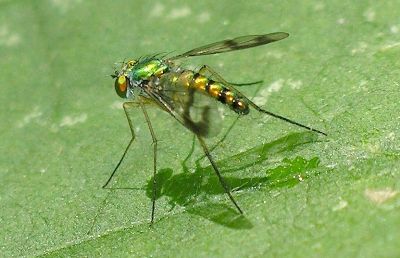by Valerie
June, 2004Texan Long-Legged Fly
Although small, the beautiful Texan long-legged fly (Condylostylus sipho) is striking enough to catch anyone's eye. Just under 3/8 inch in length, long-legged flies are very common in our yard, especially around the pond area. They come in bright metallic colors, from blue to green to copper, and often sun themselves on leaves. The Texan long-legged fly, despite its name, is very widespread and occurs over the entire eastern half of the United States, as far north as Canada. There are at least 40 related species which are difficult to identify correctly because they are so similar. At least one other species, smaller and without the dark marks on its wings, frequents our yard. There is a chance that the pictured fly is actually a different species, but I'm assuming it is probably the most common and best documented one. The reactions of flies are legendary, as anyone who has tried to swat a housefly knows, and the long-legged fly is no exception. I've found it very difficult to photograph one of these insects if it feels at all threatened because it reacts faster than the shutter on my camera. When the flash goes off, the fly can easily have leapt out of the picture frame by the time the photo is taken. Since there are plenty of different individual flies, a few of which have more sedate personalities, I have been able to successfully photograph some of them. Long-legged flies are predators, and I've sometimes seen individuals with tiny insects in their jaws. Since the flies are so small to begin with, the prey is equally miniscule. The aquatic larvae of this species are also predatory. A fly that doesn't bite us, looks lovely, and also disposes of other small insects is a very welcome addition to our garden fauna. |